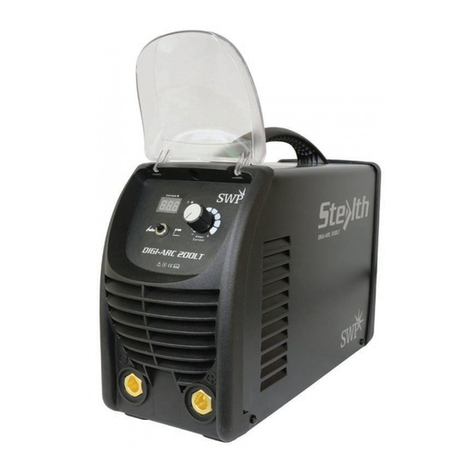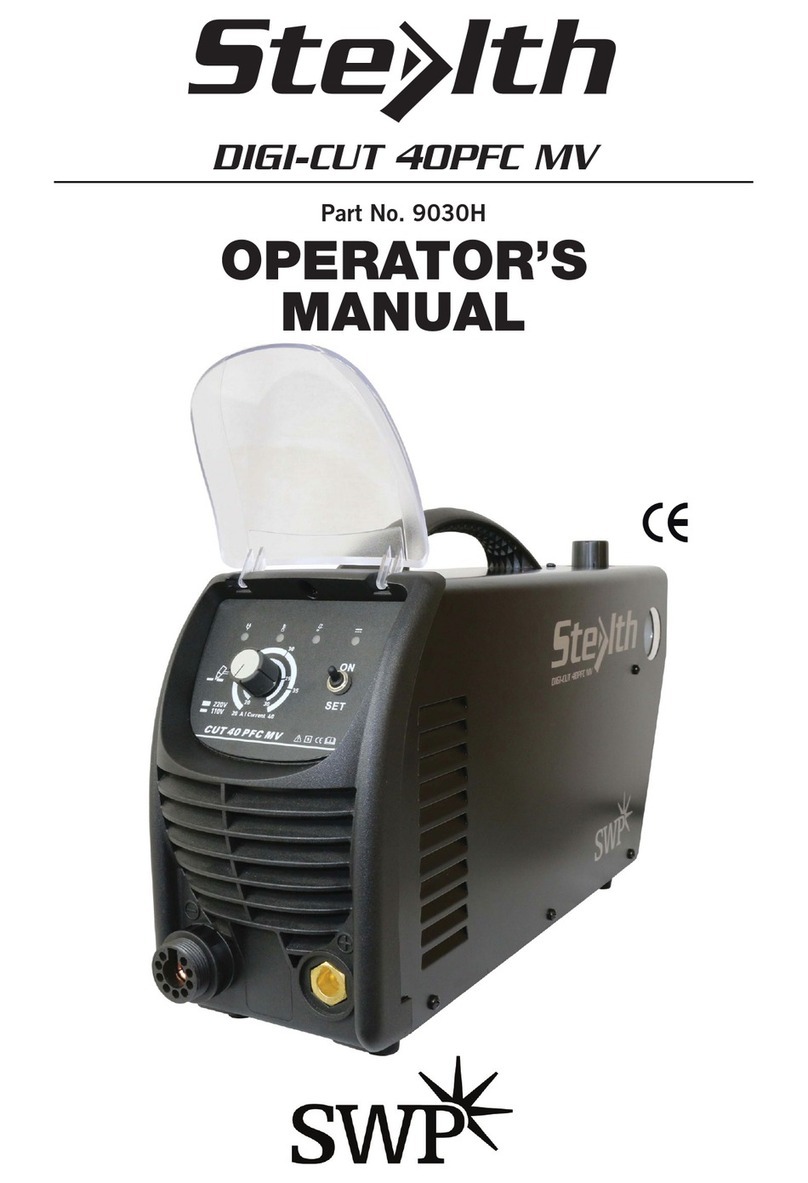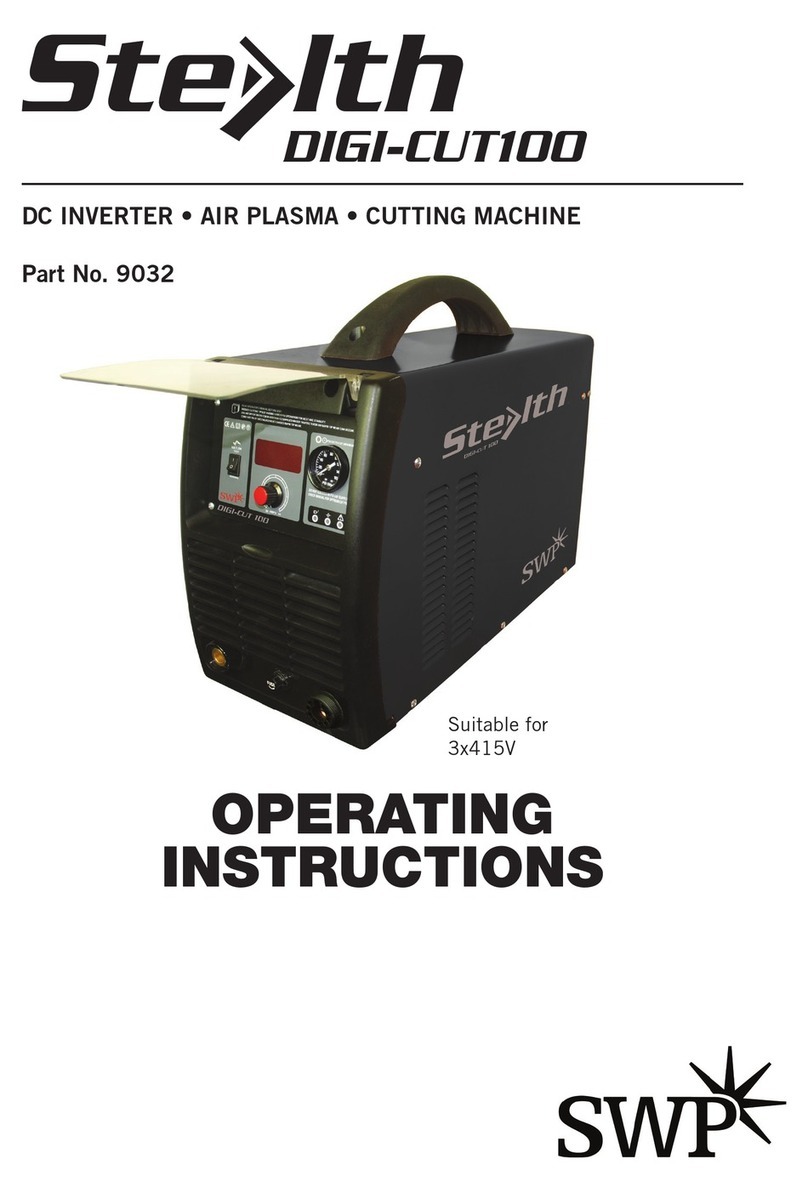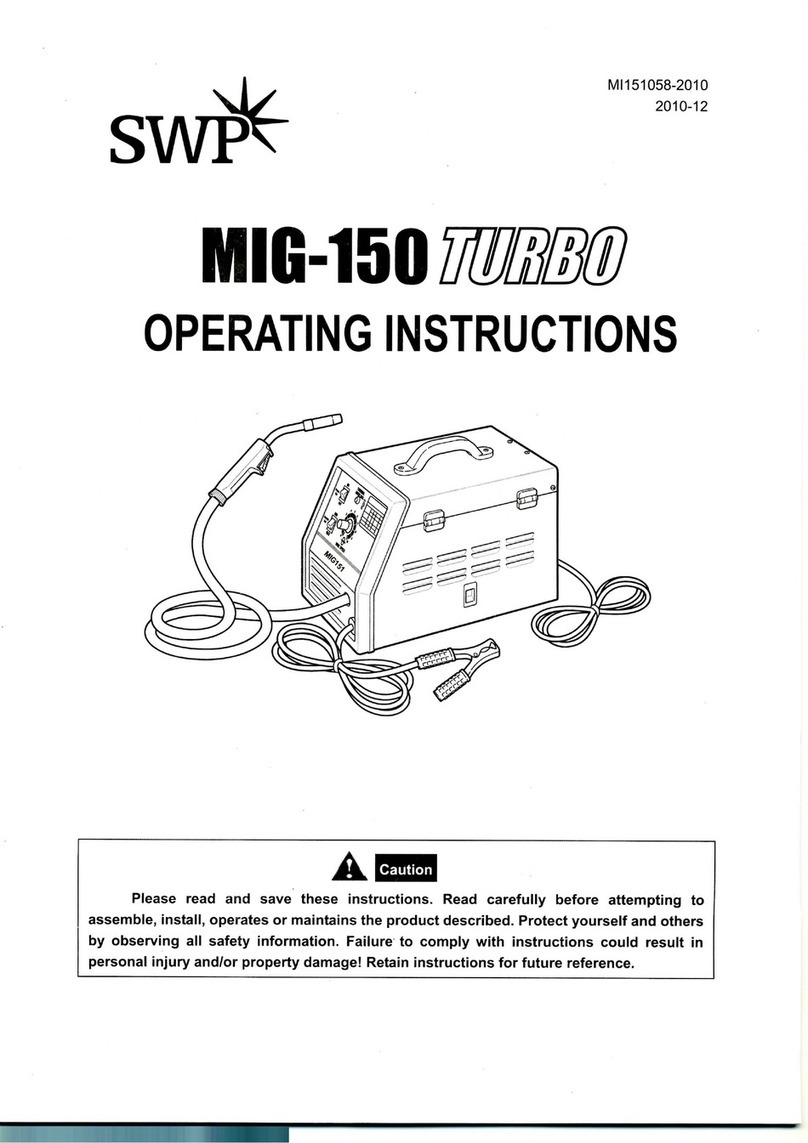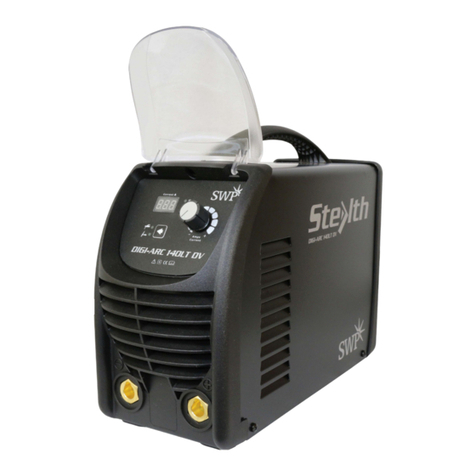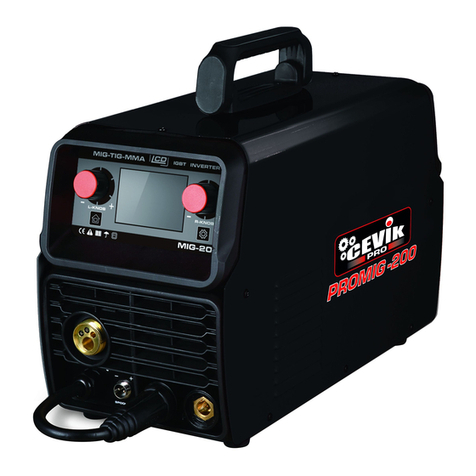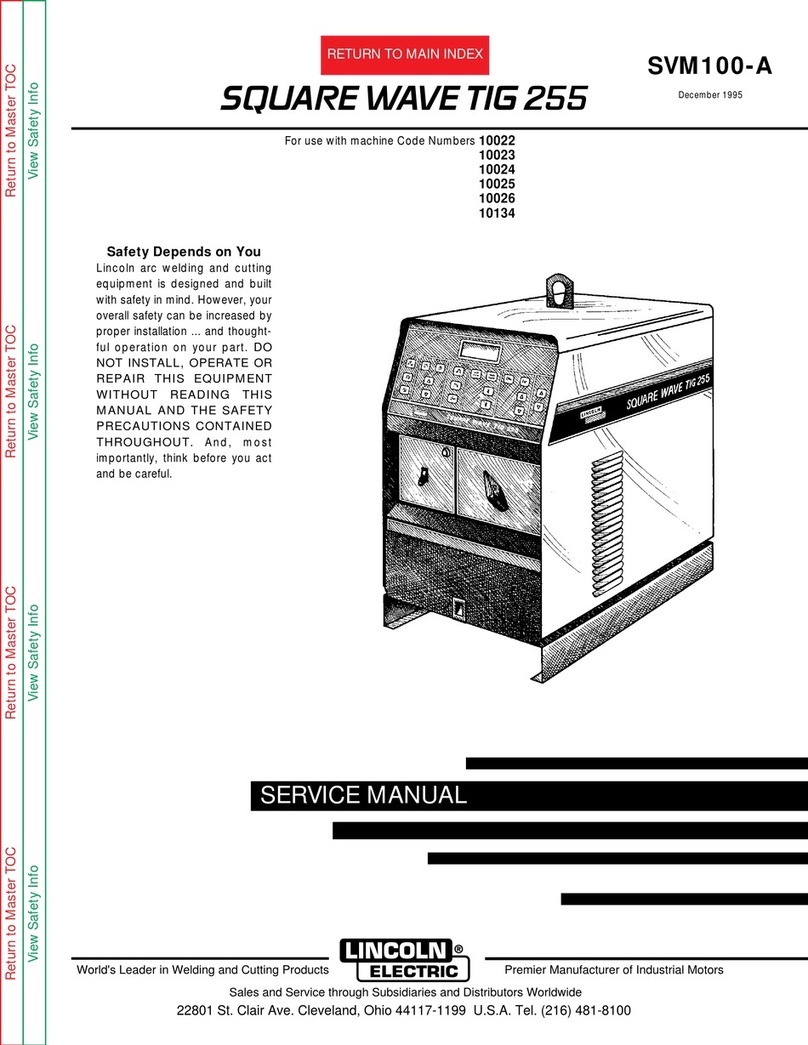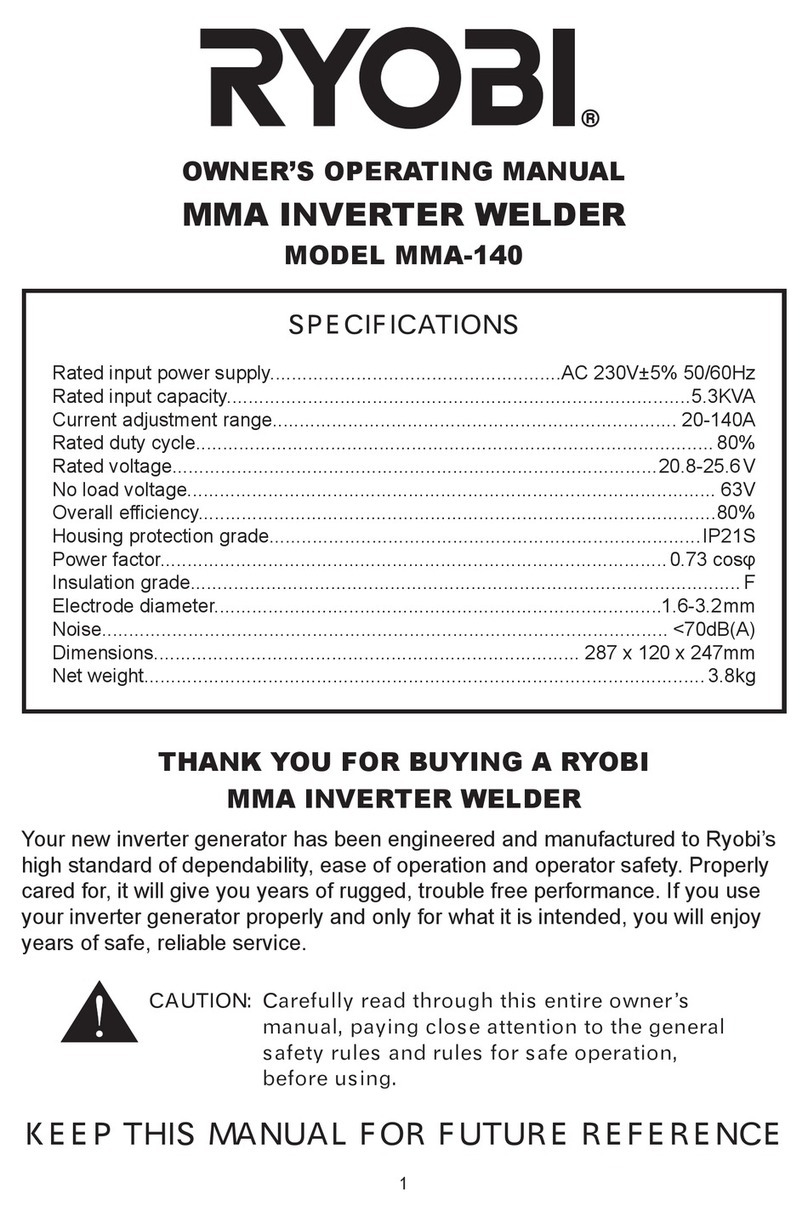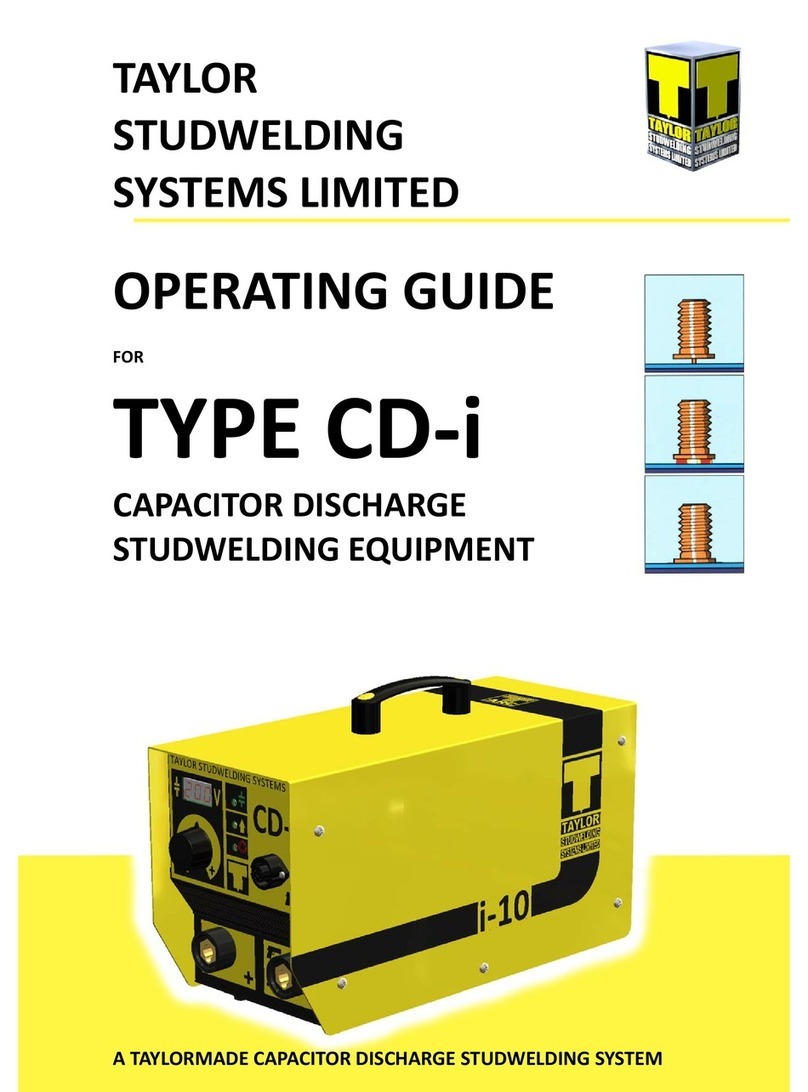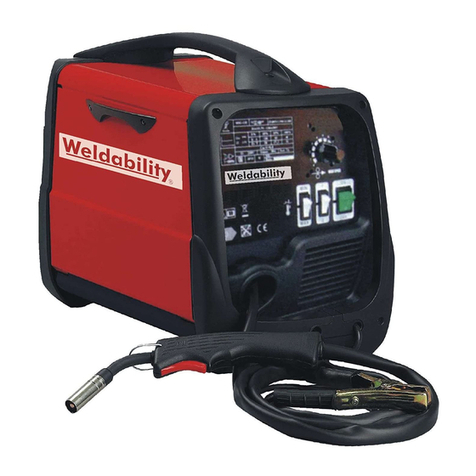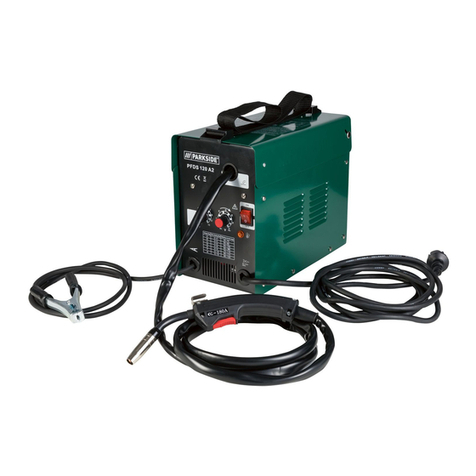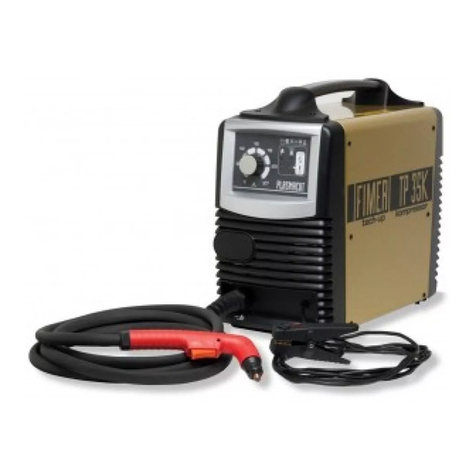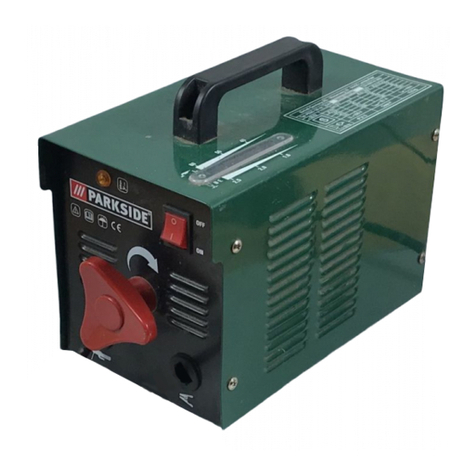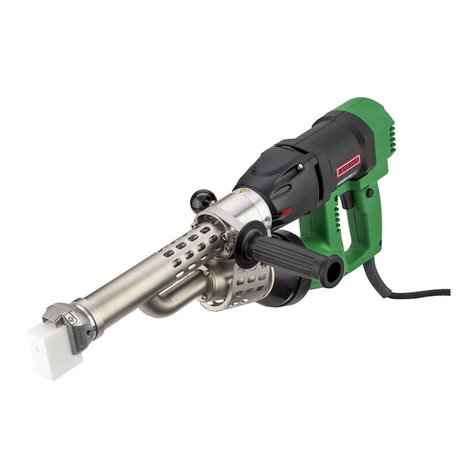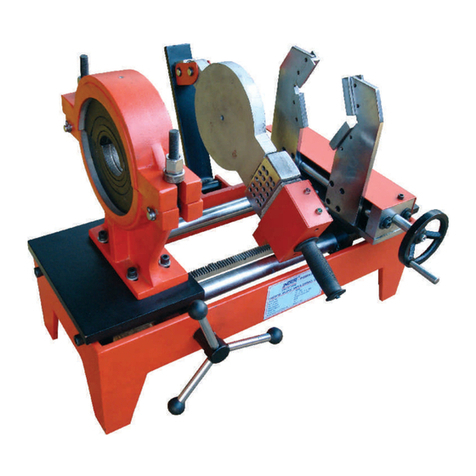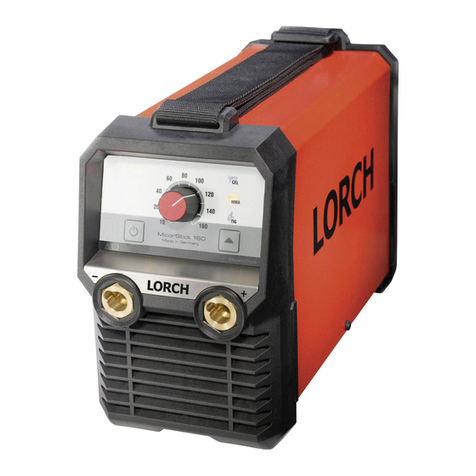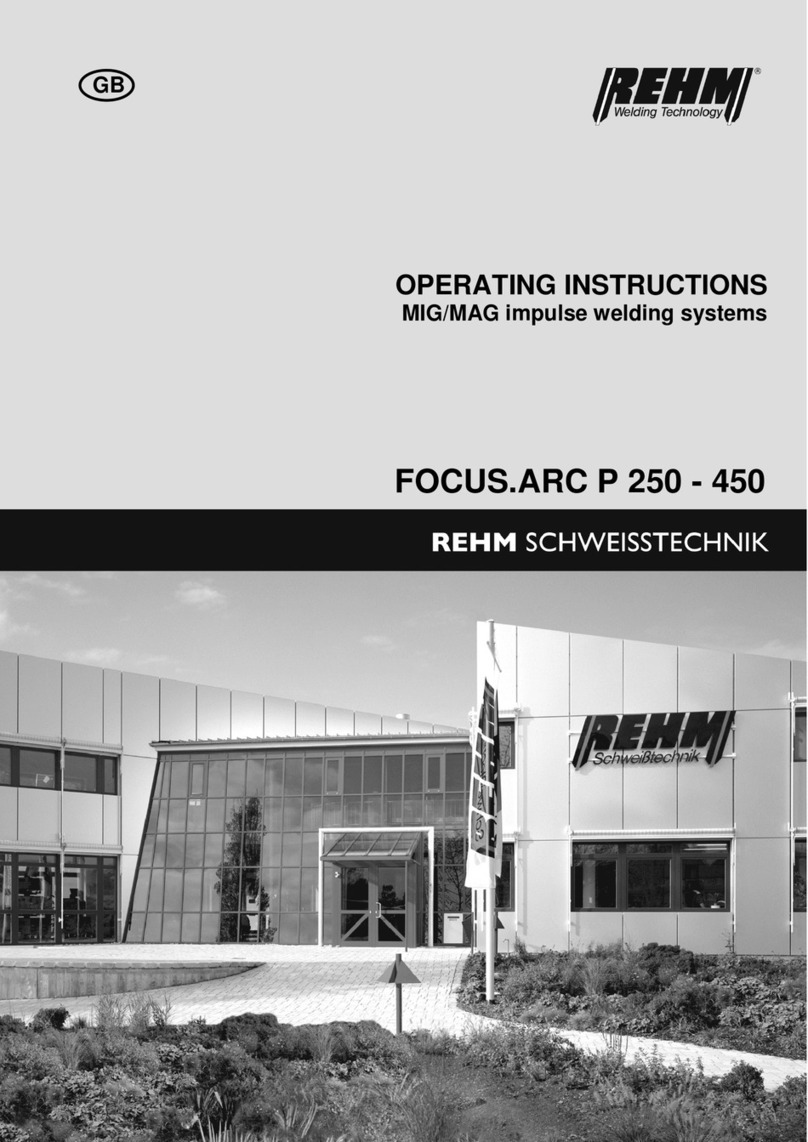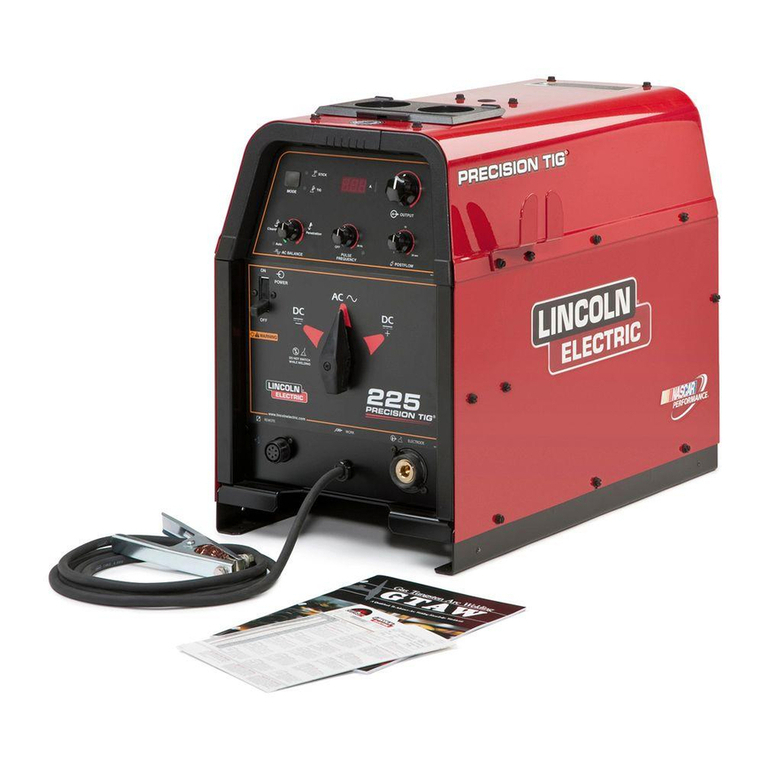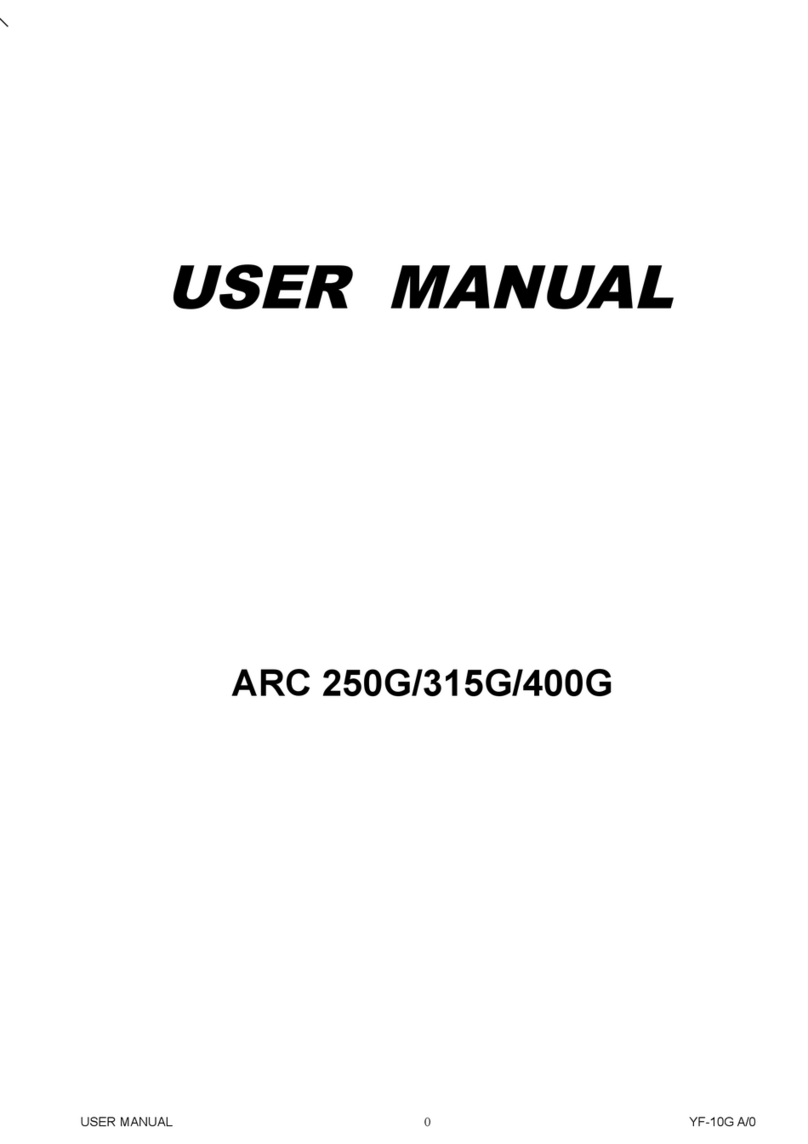SWP Digi-Cut 100 CNC User manual

Part No. 9032H
DIGI-CUT 100 CNC
OPERATOR’S
MANUAL

STEALTH DIGI-CUT 100 CNC
IMPORTANT
Read this Owner’s Manual completely before attempting to use this equipment.
Save this manual and keep it handy for quick reference. Pay particular attention
to the safety instructions provided for your protection. Contact your distributor if
you do not fully understand this manual.

CONTENTS
1 SAFETY 4
2 TECHNICAL INFORMATION 6
2.1 MAIN CIRCUIT FUNCTIONS 6
2.2 FEATURES 7
3 INSTALLATION 8
3.1 UNPACKING 8
3.2 INPUT POWER CONNECTIONS 8
3.3 GAS CONNECTIONS 8
4 OPERATION CONTROL AND CONNECTORS 9
4.1 CUTTING PREPARATION 10
4.2 CUTTING OPERATION 10
4.3 ALARM INDICATOR 11
4.4 ABOUT THE CUT VOLTAGE DIVIDER 11
5 MAINTENANCE AND TROUBLESHOOTING 14
5.1 BASIC PROBLEMS 14
5.2 PILOT ARC PROBLEMS 14
5.3 CUTTING PROBLEMS 15
6 MAIN ELECTRICAL DIAGRAM 17
7 PARTS LIST 18
STEALTH DIGI-CUT 100 CNC

OPERATION AND MAINTENANCE OF PLASMA ARC EQUIPMENT CAN BE
DANGEROUS AND HAZARDOUS TO YOUR HEALTH
Plasma arc cutting produces intense electric and magnetic emissions that may
interfere with the proper function of cardiac pacemakers, hearing aids, or other
electronic health equipment. Persons who work near plasma arc cutting applications
should consult their medical health professional and the manufacturer of the health
equipment to determine whether a hazard exists.
To prevent possible injury, read, understand and follow all warnings, safety precautions
and instructions before using the equipment.
GASES AND FUMES
Gases and fumes produced during the plasma cutting process can be dangerous and
hazardous to your health.
• Keep all fumes and gases from the breathing area. Keep your head out of the
cutting fume plume.
• Use an air-supplied respirator if ventilation is not adequate to remove all fumes and
gases.
• The types of fumes and gases from the plasma arc depend on the kind of metal
being used, metal coatings, and the different processes. You must be very careful
when cutting any metals which may contain one or more of the following:
Antimony Chromium Mercury Beryllium
Arsenic Cobalt Nickel Lead
Barium Copper Selenium Silver
Cadmium Manganese Vanadium
Always read the Material Safety Data Sheets (MSDS) that should be supplied with the
material you are using.
These MSDS will give you the information regarding the kind and amount of fumes and
gases that may be dangerous to your health.
• Use special equipment, such as water or down draft cutting tables, to capture fumes
and gases.
• Do not use the plasma torch in an area where combustible or explosive gases or
materials are located.
• Phosgene, a toxic gas, is generated from the vapours of chlorinated solvents and
cleansers. Remove all sources of these vapours.
ELECTRIC SHOCK
Electric Shock can injure or kill. The plasma arc process uses and produces high
voltage electrical energy.
This electric energy can cause severe or fatal shock to the operator or others in the
workplace.
• Never touch any parts that are electrically ‘live’ or ‘hot’.
• Wear dry gloves and clothing. Insulate yourself from the work piece or other parts of
the cutting circuit.
• Repair or replace all worn or damaged parts.
• Extra care must be taken when the workplace is moist or damp.
STEALTH DIGI-CUT 100 CNC
1 SAFETY
4
1
§1 SAFETY
Important Safety Precautions
OPERATION AND MAINTENANCE OF PLASMA ARC EQUIPMENT CAN BE DANGEROUS TO
YOUR HEALTH.
Plasma arc cutting produces intense electric and magnetic emissions that may interfere with the proper
function of cardiac pacemakers, hearing aids, or other electronic health equipment. Persons who work
near plasma arc cutting applications should consult their medical health qualified technician and the
manufacturer of the health equipment to deter- mine whether a hazard exists.
To prevent possible injury, read, understand and follow all warnings, safety precautions and instructions
before using the equipment.
GASES AND FUMES
Gases and fumes produced during the plasma cutting process can be dangerous and hazardous to your health.
Keep all fumes and gases from the breathing area. Keep your head out of the cutting fume plume.
Use an air-supplied respirator if ventilation is not adequate to remove all fumes and gases.
The kinds of fumes and gases from the plasma arc depend on the kind of metal being used, coatings on
the metal, and the different processes. You must be very careful when cutting or cutting any metals
which may contain one or more of the following:
Antimony
Chromium
Mercury
Beryllium
Arsenic
Cobalt
Nickel
Lead
Barium
Copper
Selenium
Silver
Cadmium
Manganese
Vanadium
Always read the Material Safety Data Sheets (MSDS) that should be supplied with the material you are
using.
These MSDSs will give you the information regarding the kind and amount of fumes and gases that may be
dangerous to your health.
Use special equipment, such as water or down draft cutting tables, to capture fumes and gases.
Do not use the plasma torch in an area where combustible or explosive gases or materials are located.
Phosgene, a toxic gas, is generated from the vapors of chlorinated solvents and cleansers. Remove all
sources of these vapors.
ELECTRIC SHOCK
1
§1 SAFETY
Important Safety Precautions
OPERATION AND MAINTENANCE OF PLASMA ARC EQUIPMENT CAN BE DANGEROUS TO
YOUR HEALTH.
Plasma arc cutting produces intense electric and magnetic emissions that may interfere with the proper
function of cardiac pacemakers, hearing aids, or other electronic health equipment. Persons who work
near plasma arc cutting applications should consult their medical health qualified technician and the
manufacturer of the health equipment to deter- mine whether a hazard exists.
To prevent possible injury, read, understand and follow all warnings, safety precautions and instructions
before using the equipment.
GASES AND FUMES
Gases and fumes produced during the plasma cutting process can be dangerous and hazardous to your health.
Keep all fumes and gases from the breathing area. Keep your head out of the cutting fume plume.
Use an air-supplied respirator if ventilation is not adequate to remove all fumes and gases.
The kinds of fumes and gases from the plasma arc depend on the kind of metal being used, coatings on
the metal, and the different processes. You must be very careful when cutting or cutting any metals
which may contain one or more of the following:
Antimony
Chromium
Mercury
Beryllium
Arsenic
Cobalt
Nickel
Lead
Barium
Copper
Selenium
Silver
Cadmium
Manganese
Vanadium
Always read the Material Safety Data Sheets (MSDS) that should be supplied with the material you are
using.
These MSDSs will give you the information regarding the kind and amount of fumes and gases that may be
dangerous to your health.
Use special equipment, such as water or down draft cutting tables, to capture fumes and gases.
Do not use the plasma torch in an area where combustible or explosive gases or materials are located.
Phosgene, a toxic gas, is generated from the vapors of chlorinated solvents and cleansers. Remove all
sources of these vapors.
ELECTRIC SHOCK

STEALTH DIGI-CUT 100 CNC
5
• Disconnect power source before performing any service or repairs.
• Read and follow all the instructions in the Operating Manual.
FIRE AND EXPLOSION
Fire and explosion can be caused by hot slag, sparks, or the plasma arc.
• Be sure there is no combustible or flammable material in the workplace. Any
material that cannot be removed must be protected.
• Ventilate all flammable or explosive vapours from the workplace.
• Do not cut or weld on containers that may have held combustibles.
• Provide a fire extinguisher when working in an area where fire hazards may exist.
• Hydrogen gas may be formed and trapped under aluminium workpieces when they
are cut underwater or while using a water table. DO NOT cut aluminum alloys under-
water or on a water table unless the hydrogen gas can be eliminated or dissipated.
Trapped hydrogen gas that is ignited will cause an explosion.
NOISE
Noise can cause permanent hearing loss. Plasma arc processes can cause noise levels
to exceed safe limits.
You must protect your ears from loud noise to prevent permanent loss of hearing.
• To protect your hearing from loud noise, wear protective ear plugs and/or ear muffs.
Protect others in the workplace.
• Noise levels should be measured to be sure the decibels (sound) do not exceed safe
levels.
PLASMA ARC RAYS
Plasma Arc Rays can injure your eyes and burn your skin. The plasma arc process
produces very bright ultra violet and infra red light. These arc rays will damage your
eyes and burn your skin if you are not properly protected.
• To protect your eyes, always wear a cutting helmet or shield. Also always wear safety
glasses with side shields, goggles or other protective eye wear.
• Wear cutting gloves and suitable clothing to protect your skin from the arc rays and
sparks.
• Keep helmet and safety glasses in good condition. Replace lenses when cracked,
chipped or dirty.
• Protect others in the work area from the arc rays. Use protective booths, screens or
shields.
2
• Wear dry gloves and clothing. Insulate yourself from the work piece or other parts of the cutting circuit.
• Repair or replace all worn or damaged parts.
• Extra care must be taken when the workplace is moist or damp.
• Disconnect power source before performing any service or repairs.
• Read and follow all the instructions in the Operating Manual.
FIRE AND EXPLOSION
Fire and explosion can be caused by hot slag, sparks, or the plasma arc.
• Be sure there is no combustible or flammable material in the workplace. Any material that cannot be removed
must be protected.
• Ventilate all flammable or explosive vapors from the workplace.
• Do not cut or weld on containers that may have held combustibles.
• Provide a fire watch when working in an area where fire hazards may exist.
• Hydrogen gas may be formed and trapped under aluminum workpieces when they are cut underwater or while
using a water table. DO NOT cut aluminum alloys underwater or on a water table unless the hydrogen gas can be
eliminated or dissipated. Trapped hydrogen gas that is ignited will cause an explosion.
NOISE
Noise can cause permanent hearing loss. Plasma arc processes can cause noise levels to exceed safe limits.
You must protect your ears from loud noise to prevent permanent loss of hearing.
• To protect your hearing from loud noise, wear protective ear plugs and/or ear muffs. Protect others in the
workplace.
• Noise levels should be measured to be sure the decibels (sound) do not exceed safe levels.
PLASMA ARC RAYS
Plasma Arc Rays can injure your eyes and burn your skin. The plasma arc process produces very bright ultra
violet and infra red light. These arc rays will damage your eyes and burn your skin if you are not properly protected.
• To protect your eyes, always wear a cutting helmet or shield. Also always wear safety glasses with side
shields, goggles or other protective eye wear.
• Wear cutting gloves and suitable clothing to protect your skin from the arc rays and sparks.
• Keep helmet and safety glasses in good condition. Replace lenses when cracked, chipped or dirty.
• Protect others in the work area from the arc rays. Use protective booths, screens or shields.
2
• Wear dry gloves and clothing. Insulate yourself from the work piece or other parts of the cutting circuit.
• Repair or replace all worn or damaged parts.
• Extra care must be taken when the workplace is moist or damp.
• Disconnect power source before performing any service or repairs.
• Read and follow all the instructions in the Operating Manual.
FIRE AND EXPLOSION
Fire and explosion can be caused by hot slag, sparks, or the plasma arc.
• Be sure there is no combustible or flammable material in the workplace. Any material that cannot be removed
must be protected.
• Ventilate all flammable or explosive vapors from the workplace.
• Do not cut or weld on containers that may have held combustibles.
• Provide a fire watch when working in an area where fire hazards may exist.
• Hydrogen gas may be formed and trapped under aluminum workpieces when they are cut underwater or while
using a water table. DO NOT cut aluminum alloys underwater or on a water table unless the hydrogen gas can be
eliminated or dissipated. Trapped hydrogen gas that is ignited will cause an explosion.
NOISE
Noise can cause permanent hearing loss. Plasma arc processes can cause noise levels to exceed safe limits.
You must protect your ears from loud noise to prevent permanent loss of hearing.
• To protect your hearing from loud noise, wear protective ear plugs and/or ear muffs. Protect others in the
workplace.
• Noise levels should be measured to be sure the decibels (sound) do not exceed safe levels.
PLASMA ARC RAYS
Plasma Arc Rays can injure your eyes and burn your skin. The plasma arc process produces very bright ultra
violet and infra red light. These arc rays will damage your eyes and burn your skin if you are not properly protected.
• To protect your eyes, always wear a cutting helmet or shield. Also always wear safety glasses with side
shields, goggles or other protective eye wear.
• Wear cutting gloves and suitable clothing to protect your skin from the arc rays and sparks.
• Keep helmet and safety glasses in good condition. Replace lenses when cracked, chipped or dirty.
• Protect others in the work area from the arc rays. Use protective booths, screens or shields.
2
• Wear dry gloves and clothing. Insulate yourself from the work piece or other parts of the cutting circuit.
• Repair or replace all worn or damaged parts.
• Extra care must be taken when the workplace is moist or damp.
• Disconnect power source before performing any service or repairs.
• Read and follow all the instructions in the Operating Manual.
FIRE AND EXPLOSION
Fire and explosion can be caused by hot slag, sparks, or the plasma arc.
• Be sure there is no combustible or flammable material in the workplace. Any material that cannot be removed
must be protected.
• Ventilate all flammable or explosive vapors from the workplace.
• Do not cut or weld on containers that may have held combustibles.
• Provide a fire watch when working in an area where fire hazards may exist.
• Hydrogen gas may be formed and trapped under aluminum workpieces when they are cut underwater or while
using a water table. DO NOT cut aluminum alloys underwater or on a water table unless the hydrogen gas can be
eliminated or dissipated. Trapped hydrogen gas that is ignited will cause an explosion.
NOISE
Noise can cause permanent hearing loss. Plasma arc processes can cause noise levels to exceed safe limits.
You must protect your ears from loud noise to prevent permanent loss of hearing.
• To protect your hearing from loud noise, wear protective ear plugs and/or ear muffs. Protect others in the
workplace.
• Noise levels should be measured to be sure the decibels (sound) do not exceed safe levels.
PLASMA ARC RAYS
Plasma Arc Rays can injure your eyes and burn your skin. The plasma arc process produces very bright ultra
violet and infra red light. These arc rays will damage your eyes and burn your skin if you are not properly protected.
• To protect your eyes, always wear a cutting helmet or shield. Also always wear safety glasses with side
shields, goggles or other protective eye wear.
• Wear cutting gloves and suitable clothing to protect your skin from the arc rays and sparks.
• Keep helmet and safety glasses in good condition. Replace lenses when cracked, chipped or dirty.
• Protect others in the work area from the arc rays. Use protective booths, screens or shields.

STEALTH DIGI-CUT 100 CNC
6
2 TECHNICAL INFORMATION
2.1 Main circuit functions
The working principle of DIGI-CUT 100 CNC Air Plasma Cutting Machine is shown
as the following figure. Three-phase 380V work frequency AC is rectified into DC
(about 530V), then it is converted to medium frequency AC (about 20 KHz) by the
inverter device (discrete IGBT). The voltage is reduced via the medium transformer and
rectified by the medium frequency rectifier (fast recovery diode) then outputted by
inductance filtering. The circuit adopts current feedback control technology to ensure
the current output is stable. The cutting current parameter can be adjusted
continuously to meet with the requirements of cutting.
4
§2 Technology Parameters
2.1 Working principle of main circuit
The working principle of CUT 100 Air Plasma Cutting Machine is shown as the following figure.
Three-phase 380V work frequency AC is rectified into DC (about 530V), then it is converted to medium
frequency AC (about 20 KHz) by inverter device (discrete IGBT), after reducing voltage by medium
transformer (the main transformer) and rectified by medium frequency rectifier (fast recovery diode), and is
outputted by inductance filtering. The circuit adopts current feedback control technology to insure current
output stably. Meanwhile, the cutting current parameter can be adjusted continuously and steplessly to meet
with the requirements of cutting craft.
Rectify Inverter
Medium
frequency
transformer
Medium
frequency
rectify
Hall device
Current positive-
feedback control
Three-phase, AC DC AC DC
380V,50Hz
AC DC
fig 2.1 Working principle diagram
2.2Parameters:
Table2.1 Technical parameters
Models
Parameters
CUT 80 CNC
CUT 100 CNC
Rated input voltage(V)
3-380/400/440V±10%
3-380/400/440V±10%
Fre.(HZ)
50/60
50/60
Rated input current(A)
20
28
Rated input power(KW)
11
14.5
Cutting current adjustment range (A)
20~80
20~100
No-load voltage(V)
400
420
Duty cycle(40�10minutes)
100% 80A 110V
100% 100A 125V
Severance Cut for Carbon Steel(mm)
≤45
≤60
Optimal cutting thickness (mm)
Carbon steel
≤30
≤45
Stainless steel
≤30
≤45
Aluminum
≤25
≤36
Cooper
≤15
≤20
Dimensions(mm)
630*240*445
630*240*445
Fig. 2.1 Working principle diagram

DIGI-CUT 100 CNC
Power Supply Voltage (V) 3~400±10%
Frequency Hz 50/60
Rated input current (A) 28
Rated input power (Kw) 14.5
Adjustment range of current (A) 20~100
Max no-load voltage (V) 420
Duty cycle (40ºC / 10 minutes) 100A @ 80%
Severance Cut for Carbon Steel (mm) ≤60
Carbon Steel ≤45
Optimal cutting Stainless Steel ≤45
thickness (mm) Aluminium ≤36
Copper ≤20
Dimensions (mm) L x H x W 630 x 240 x 445
Protection class IP23
Insulation class H
Net weight (Kg) 30.5
Cooling method AF
STEALTH DIGI-CUT 100 CNC
7
Table 2.1 Technical information
2.2 Features
2.3.1 IGBT parallel balanced current technology and digital control technology.
2.3.2 Wider input voltage flexibility provides peak performance power under variable
conditions (±15%) for steady cuts.
2.3.3 EMI filter restrains the EMI transmission of the power.
2.3.4 Starts without high-frequency so it will not interfere with controls or computers.
2.3.5 Pilot Arc Controller increases cutting capabilities and speeds, and improves tip
life.
2.3.6 Various protective and alarm functions over-temperature and over-current allow
faster troubleshooting and eliminates unnecessary downtime.
2.3.7 Back striking tip and electrode ensure velocity of striking and quality of arc for
prolonged usage.

3 INSTALLATION
3.1 Unpacking
Use the packing lists to identify and account for each item.
3.1.1 Inspect each item for possible shipping damage. If damage is evident, contact
your distributor and / or shipping company before proceeding with the
installation.
3.1.2 When using a forklift, its arm length must be long enough to reach the outside
so as to ensure safe lifting.
3.1.3 The movement may cause potential danger or substantive hazard. Make sure
the machine is in a safe position before using.
3.2 Input Power Connections
Supply input connection of CUT 60 power is shown as the Fig 3.1.
3.2.1 Check your power source for correct voltage before plugging
in or connecting the unit
3.2.2 Power Cord and Plug. This power supply includes an
input power cord and plug suitable for 220V AC 1 –
Phase input power.
3.2.3 If the power supply voltage continually goes beyond
the range of safe work voltage range, it will shorten
the machine’s life-span. The following measures can
be used:
• Change the power supply input, eg. connect the
machine with the stable power supply voltage of
distributor.
• Reduce the machine’s power supply at the same
time.
• Set the voltage stabilisation device in the front of power cable input.
3.3 Gas Connections
3.3.1 Connecting Gas Supply to Unit
Connect the gas line to the inlet port of the gas filter on the rear panel.
3.3.2 Check Air Quality
To test the quality of air, put the RUN / SET switch in the SET (down) position.
Check if there is any oil or moisture in the air.
6
§3 Installation
3. 1 Unpacking
Use the packing lists to identify and account for each item.
1. Inspect each item for possible shipping damage. If damage is evident, contact your distributor and / or
shipping company before proceeding with the installation.
2. When using forklift, its arm length must be long enough to reach the outside so as to ensure lifting
safely.
3. The movement may bring the potential danger or substantive hazard, so please make sure that the
machine is on the safe position before using.
3.2 Input Power Connections
Supply input connection of CUT 100 power is shown as the
Fig3.1.
1. Check your power source for correct voltage before plugging in
or connecting the unit
2. Power Cord and Plug This power supply includes an input power
cord and plug suitable for 380V AC 3 - Phase input power.
3. If the power supply voltage continually goes beyond the range of
safe work voltage range, it will shorten the welder life-span. The
following measures can be used:
Change the power supply input. Such as, connect the welder with
the stable power supply voltage of distributor;
Reduce the machines using power supply in the same time;
Set the voltage stabilization device in the front of power cable
input.
3. 3Gas Connections
1. Connecting Gas Supply to Unit
Connect the gas line to the inlet port of the gas filter on the rear panel.
2. Check Air Quality
To test the quality of air, put the RUN / SET switch in the SET (down) position, check if there are Any
oil or moisture in the air.
Live wire
Earth wire
3~380V
Power
cable
Rear panel
Distrubutor
Earth wire
Live wire
Power
input
Power
switch
Power
cable input
Fig 3.1 the connect method of
the main supply
STEALTH DIGI-CUT 100 CNC
8
Fig. 3.1 Correct method
of main supply

STEALTH DIGI-CUT 100 CNC
9
4 OPERATION CONTROL AND CONNECTORS
1. Cutting current regulator – used to regulate the current when cutting.
2. Power pilot lamp
3. Over-current / Over-heat alarm – when over-heat or over-current, the lamp would is lit.
4. Current display
5. Cutting gun incorrect installation and air pressure low alarm
6. Barometer display
7. Work lamp – turn on the switch of the cutting gun, generate the voltage, the lamp on
8. RUN/SET – when cutting the workpiece, turn to ‘RUN’. When performing a gas test,
turn to ‘SET’.
9. Cutting gun connector – connect to the cutting machine.
10. Remote control plug
11. Positive output cable – connect to the workpiece.
12. Barometer – ensure there is no impurity and moisture in the compressed air.
13. Power cable – connect to the appropriate power supply.
14. Power switch – turn on or off the power source.
7
§4 Operation
4.1 Layout Of The Front And Rear Panel:
Fig 4.1 schematic drawing of the front panel and rear panel
1.Cutting current regulator: it is used to regulate the current when cutting.
2. Power pilot lamp
3. Over-current ,over-heat alarm :when over-heat, over-current, the lamp would be on.
4.Current display
5.Cutting gun improper installation and air pressure low alarm
6.Barometer display
7. Work lamp: turn on the switch of the cutting gun, generate the voltage, the lamp on
8. RUN/SET: when cutting the workpiece, turn to the “RUN”; when doing gas test, turn to the “SET”.
9.Cutting gun connector: connected to the cutting machine
10.remote control plug
11.Positive output cable: connected to the workpiece
12.Barometer :ensure there are no impurity and moisture in the compressed air
13.Power cable: connected to the appreciate power supply
14.Power switch: turn on or off the power source

STEALTH DIGI-CUT 100 CNC
10
4.1 Cutting Preparation
4.2.1 Tightly connect the power cable to an electrical socket outlet (refer to the Input
Voltage in section 2 Technology Parameters).
4.2.2 Connect the air pipe to the air supply equipment and the earth cable to the
workpiece.
4.2.3 Turn on the power switch, the power source lamp is lit.
4.2.4 Turn the RUN/SET switch to SET position – the air flows, Regulate the air
pressure to 3.5-6.0 bar
4.2.5 Turn the RUN/SET switch to RUN position. Regulate the current after the flow
stops.
4.2.6 Preparation is complete.
NOTE (1) The alarm lamp is on when cutting. Switch off the torch until the alarm
sounds, then press the switch again to restart cutting.
(2) During automatic gas test and examination, press on the cutting torch.
(3) After long use, the surface of the electrode and nozzle will have an oxidation
reaction. Replace the electrode and nozzle. The alarm lamp will light when
you remove the shield cup as a safety precaution.
(4) If the cutting current is higher than 40A when the tip touches the work-
piece, the current will reduce to 40A in order to protect the tip.
(5) During post gas, if you hold down the trigger for a long time the arc restarts,
if you press and loosen the trigger quickly the gas stops, you can then hold
down the trigger to restart the machine.
4.2 Cutting Operation
8
4.2 Cutting Preparation
1) Tightly connect the power cable to electrical socket outlet (the input voltage, refer to the section 2
technology parameters)
2) Tonnect the air pipe to the air supply equipment, the earth cable to the workpiece
3) Turn on the power switch ,the power source lamp on.
4) Turn the RUN/SET switch to SET position, the air flow, then regulate the air pressure to 3.5-6bar
5) Turn the RUN/SET switch to RUN position, regulate the current after the flow stops.
6) Now all the preparation done .
4.3 Cutting Operation
1. NormalCut
Note:
1) The alarm lamp on when cutting, it is needed to loose the switch of the torch until the alarm release,
then press on the switch to restart working.
Turn on
the power
source
Automatic
gas test for
10S
Loose the
cutting torch
trigge.
Pre-gas
for 1s
The torch move away
the workpiece, then ,
the arc stops
Automatic
examine
for 5s
After
Initializationpress
on the torch trigger
Ignite the
pilotarc.
Post-gas
Time 20s
If the tiptouch the
workpiece and the
current high
er than
25A, isn’t it ?
Shift to the
workpiece, the
pilot arc change
into cutting arc
Yes
No
The current
will down to
25A
Cutting
Is the torch trigger
pressed on again among
the period of post-gas ?
Yes
No
Restart and continue
working
Finish after post-gas
for seting time<1>

STEALTH DIGI-CUT 100 CNC
11
4.3 Alarm Indicator
4.3.1 When the machine appears to over-heat or over-current, the yellow indicator
(lamp 2) on the front panel remain on.
• Over-heat – the alarm will release after the fan cooling period. You can then
restart the machine.
• Over-current – the alarm is beyond retrieve. You must ask a qualified
technician to check the machine.
4.3.2 When any of the torch parts (including tip, electrode, shield cup and gas
distributor) are not correctly installed, the red indicator (lamp 3) lights.
4.3.3 When the air pressure is too low, the indicator (lamp 3) will remain on.
4.3.4 When the gas distributor is un-installed, there is no alarm while operating the
machine and when the trigger is pressed, there is no arc and no load. Open the
torch and check.
4.4 About the CUT voltage divider
CUT power supplies are equipped with an optional, factory-installed, four-position
voltage divider that is designed to be safely connected without tools. The built-in
voltage divider provides a scaled downarc voltage of 20:1, 30:1, 40:1, and 50:1
(maximum output of 18V). An optional receptacle on the rear of the power supply
provides access to the scaled down arc voltage and signals for arc transfer and plasma
start.
NOTE The factory presets the voltage divider to 20:1. To change the voltage divider to
a different setting, refer to the section on the next page.
The factory-installed internal voltage divider provides a maximum of 18V under
open circuit conditions. This is an impedance-protected functional extra low voltage
(ELV) output to prevent shock energy, and fire under normal conditions at the
machine interface receptacle and under single fault conditions with the machine
interface wiring. The voltage divider is not fault tolerant and ELV outputs do not
comply with safety extra low voltage (SELV) requirements for direct connection to
computer products.

STEALTH DIGI-CUT 100 CNC
12
NOTE The cover on the machine interface receptacle prevents dust and moisture
from damage when not in use. This cover should be replaced if damaged or
lost. Installation of the machine interface cable must be performed by a
qualified service technician. To install a machine interface cable:
1. Turn OFF the power and disconnect the power cord.
2. Remove the machine interface receptacle’s cover from the rear of the
power supply.
3. Connect the machine interface cable to the power supply.
Refer to the following table when connecting the CUT system to a torch height controller or
CNC controller with a machine interface cable.
Signal Type Instruction Connector socket Cable ends
Normally open.
18 VDC open circuit voltage
Start (start Input at START terminals. 8, 9 8 (yellow
plasma) Requires dry contact closure 9 (green)
to activate.
Normally open. Dry contact
Transfer (start closure when the arc transfers.
machine 120 VAC/1 A maximum at the 13 (blue)
motion) Output machine interface relay or 13, 14 14 (white)
switching device (supplied by
the customer).
Ground Ground
CUT: Divided arc signal of 6 (red)Voltage Output 20:1, 30:1, 40:1, 50:1 6 (+), 7 (–) 7 (black)divider (provides a maximum of 18 V).
10
with the machine interfacewiring. The voltage divider is not fault tolerant and
ELV outputs do not comply withsafety extra low voltage (SELV) requirements
for direct connection to computerproducts.
Note:
The cover on the machine interface receptacle prevents dust and moisture from damaging the receptacle
when not in use. This cover should be replaced if damaged or lost.
Installation of the machine interface cable must be performed by a qualified service technician. To install a
machine interface cable:
1. Turn OFF the power and disconnect the power cord.
2. Remove the machine interface receptacle’s cover from the rear of the power supply.
3. Connect the machine interface cable to the power supply.
13
47
8
11
1214
Divider output
The large arc
signal connection
Gun switch signal
connection
The small arc
signal connection
Refer to the following table when connecting the CUT system to a torch height controller or CNC controller
with a machine interface cable.
signal
type
Instruction
The connector socket
Cable ends
Start (start
plasma)
Input
Normally open.
18 VDC open circuit voltage at
START terminals.
Requires dry contact closure to
activate.
8、9
8(yellow)、
9(green)
Transfer(start
machine
motion)
Output
Normally open. Dry contact
closure when the arctransfers.
120 VAC/1 A maximum at the
machine interface relayor
switching device (supplied by
the customer).
13、14
13(blue)、
14(white)
Ground
Ground
Voltagedivid
er
Output
CUT: Divided arc signal of
20:1,30:1, 40:1, 50:1 (provides a
maximum of 18 V).
6(+)、 7(-)
6(red)、 7
(black)
Setting the five-position voltage divider on the CUT
The factory presets the voltage divider to 20:1. To change the voltage divider to a different setting:
1. Turn OFF the power supply and disconnect the power cord.
2. Remove the power supply cover.

STEALTH DIGI-CUT 100 CNC
13
Setting the five-position CUT voltage divider
The factory presets the voltage divider to 20:1. To change the voltage divider to a different
setting:
1. Turn OFF the power supply and disconnect the power cord.
2. Remove the power supply cover.
3. Locate the voltage divider DIP switches on the left side of the power supply.
Shift and Scale Selection
Dial Scale Selection
Number 20:1 30:1 40:1 50:1
1 ON 1 1 1
2 2 ON 2 2
3 3 3 ON 3
4 4 4 4 ON
CNC Control Cable Selectable Type
Number Standard (m)
6.310.660 5
6.310.660-D 10
6.310660-E 15

STEALTH DIGI-CUT 100 CNC
14
5 MAINTENANCE AND TROUBLESHOOTING
WARNING There are extremely dangerous voltage and power levels present inside this
unit. Do not attempt to diagnose or repair unless you have had training in
power electronics measurement and troubleshooting techniques.
5.1 BASIC PROBLEMS
5.1.1 When the machine is turned on, the power indicator lights up but both the fan
and the air control valve are not working.
5.1.1.1 Check the input lines and reconnect as necessary.
5.1.1.2 The main board in the machine has failed. A qualified technician
should change it.
5.1.2 Turn on the machine – the TIP/GUN/GAS indicator lights up.
5.1.2.1 Gas pressure is too low. Adjust the gas pressure to 65psi/4.5bar and
the barometer indicator to 0.45~0.5MPa.
5.1.3 Turn on the machine – the TIP/GUN/GAS indicator flickers.
5.1.3.1 The shield cup is not properly installed. Turn off the power source,
install and secure a good fit. Turn on the power source.
5.1.3.2 The Tip or electrode is not properly installed. Turn off the power
source and install the shield cup securely. Turn on the power source.
5.1.4 The temperature indicator lights up after the machine has only been on for a
short time.
5.1.4.1 Check for blocked air flow around the unit and correct as necessary.
5.1.4.2 Fan blocked. Check and correct as necessary.
5.1.4.3 The machine is over-heating. Let it cool down for at least five
minutes. Ensure the machine has not been operated beyond the
Duty Cycle (refer to Technical Information in Section 2).
5.1.4.4 Input voltage is over the normal range. Select the correct voltage
(refer to Technical Information in Section 2).
5.1.4.5 Faulty components in the machine. Return for repair or have a
qualified technician repair with reference to the Service Manual.
5.2 PILOT ARC PROBLEMS
5.2.1 Torch failed to ignite the arc when torch is triggered.
5.2.1.1 The system is set in ‘SET’ mode. Change to ‘RUN’ mode.
5.2.1.2 Faulty torch parts. Inspect and replace as necessary.
5.2.1.3 Gas pressure is too high or too low. Adjust to correct setting.
5.2.1.4 Faulty components in the machine. Return for repair or have a
qualified technician repair with reference to the Service Manual.

5.2.2 Difficulty igniting
5.2.2.1 The gas distributor is not installed correctly.
5.2.2.2 Worn torch parts (consumables). Shut off input power. Remove and
inspect torch shield cup, tip, starter cartridge, and electrode. Replace
electrode or tip if worn. Replace starter cartridge if end piece does not
move freely. Replace shield cup if excessive spatter adheres to it.
5.2.2.3 The machine is in trouble. Have a qualified technician repair with
reference to the Service Manual.
5.2.3 The torch is triggered but the pilot arc does not change to the cutting pilot.
The power indicator lights up. Gas flows. Fan operates.
5.2.3.1 Inaccurate connection between torch and power supply. Check the
torch leads are properly connected to a power supply.
5.2.3.2 Work cable not connected to work piece or connection is poor. Ensure
that work cable has an efficient connection to a clean and dry area of
the workpiece.
5.2.3.3 Faulty components in the machine. Return for repair or have a
qualified technician repair with reference to the Service Manual.
5.2.3.4 Faulty Torch. Return for repair or have qualified technician repair it.
5.2.4 Arc shuts off during operation and will not restart when torch is triggered.
5.2.4.1 Power Supply is overheated (OC/OT lamp lit) Let unit cool down for at
least five minutes. Ensure the unit has not been operated beyond
Duty Cycle limit. Refer to Section 2 for duty cycle specifications.
5.2.4.2 Gas pressure too low (the TIP/GUN/GAS lamp is lit when torch switch
is pressed on). Check source for at least 65 psi / 4.5 bar; adjust as
necessary.
5.2.4.3 Torch consumables worn. Check torch shield cup, tip, starter element,
electrode and replace as necessary.
5.2.4.4 Faulty components in unit. Return for repair or have a qualified
technician repair with reference to the Service Manual.
5.3 CUTTING PROBLEMS
5.3.1 No gas flow. The power lamp is lit and fan operates.
5.3.1.1 Gas pipe not connected or pressure is too low. Check gas connections.
Adjust gas pressure to proper setting.
5.3.1.2 Faulty components in the unit. Return for repair or have a qualified
technician repair with reference to the Service Manual.
5.3.2 Low Cutting Output
5.3.2.1 Incorrect setting of cutting current (A). Check and adjust to correct
setting.
5.3.2.2 Faulty components in unit. Return for repair or have a qualified
technician repair with reference to the Service Manual.
15
STEALTH DIGI-CUT 100 CNC

5.3.3 Torch cuts but the cutting quality is poor.
5.3.3.1 Current (A) control set too low. Increase current setting.
5.3.3.2 Torch moves too fast across the workpiece. Reduce cutting speed.
5.3.3.3 Excessive oil or moisture in torch. Hold torch (3 mm) from clean
surface while purging and observe oil or moisture build-up (do not
activate torch). If there are contaminants in the gas, additional
filtering may be needed.
5.3.3.4 Lack of air pressure. Check the air pressure and air flow and adjust
to the appropriate position.
STEALTH DIGI-CUT 100 CNC
16

17
STEALTH DIGI-CUT 100 CNC
6 MAIN ELECTRICAL DIAGRAM
Appendix 1: Electrical principle drawing

18
STEALTH DIGI-CUT 100 CNC
7 PARTS LIST
9032H-02 COVER
9032H-04 FAN
9032H-04 ON/OFF SWITCH
9032H-06 AIR FILTER – USE 9030H
9032H-09 REAR PANEL
9032H-13 BASE
9032H-22 FRONT PANEL
9032H-25 CENTRAL SOCKET – USE 9030H-17
9032H-27 KNOB – USE 9000H-33
9032H-29 FRONT PCB
9032H-31 CONTROL PCB
9032H-33 SOLENOID VALVE
9032H-38 AUX PCB
9032H-41 DRIVER PCB
9032H-42 CAP PCB
9032H-43 EMC FILTER
9032H-A01 FILTER PCB
9032H-49 MAIN PCB ASSEMBLY

STEALTH DIGI-CUT 100 CNC
19

STEALTH DIGI-CUT 100 CNC
Specialised Welding Products Ltd
Unit 1, Farringdon Industrial Centre, Farringdon, Nr Alton, Hampshire GU34 3DD, UK
This manual suits for next models
1
Table of contents
Other SWP Welding System manuals


